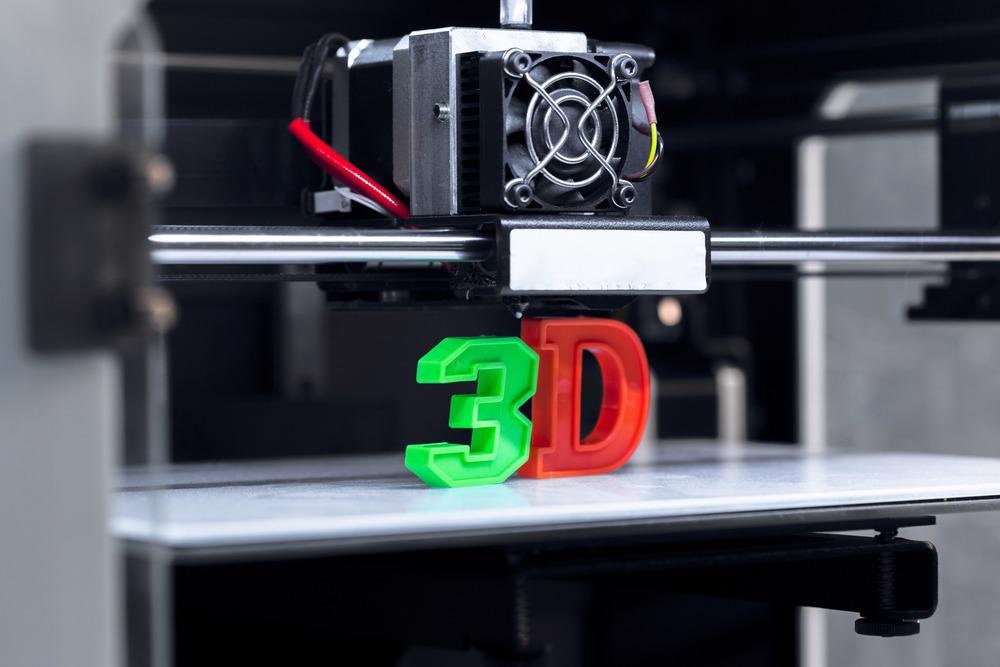A team of researchers recently published a paper in the journal ACS Applied Materials & Interfaces that demonstrated the effectiveness of near-infrared (NIR) light-based three-dimensional (3D) printing methods in improving the feature fidelity of composite 3D printed structures.

Study: “Invisible” Digital Light Processing 3D Printing with Near Infrared Light. Image Credit: FabrikaSimf/Shutterstock.com
Background
In recent years, additive manufacturing technology or 3D printing has experienced substantial growth due to its low cost of equipment, low waste generation, high feature resolution, and enhanced manufacturing speed compared to traditional subtractive technology.
In the modern light-based 3D printing methods such as liquid crystal display (LCD) and digital light processing (DLP) printing, every layer of the proposed 3D printed structure is photocured by a series of two-dimensional (2D) image projections with a spatiotemporal control.
These methods offer an exceptional combination of feature resolution of less than100 μm and speed of fewer than five seconds per layer at manageable printer footprints and affordable prices.
However, the reliance on violet and ultraviolet (UV) light-activated chemistry hinders the use of several accessible materials in photopolymerization. Thus, NIR light with a wavelength of 780 nm and milder visible light within the wavelength range of 400−780 nm were used in the 3D printing method to facilitate the production of resins such as nanoparticles that considerably attenuate violet-UV light through scattering and absorption.
In this study, a three-component photosystem was photocured using a NIR LED in DLP 3D printing to study the feature fidelity of the composite printed structures.
The Study
2,2,6,6-Tetramethyl-1-piperidinyloxy (TEMPO) was added to pentaerythritol tetrakis (3-mercaptopropionate) (PETMP) and 1,6-hexanediol diacrylate (HDDA), respectively to prepare the stock solutions required for resin preparation.
H-Nu 815, a cyanine derivative, was used as a photoredox catalyst.
Initially, PETMP and HDDA stock solutions were added, followed by the other photosystem components that include diphenyliodonium as an electron acceptor, butyltriphenylborate as electron donor, and H-Nu 815.
Subsequently, a 130 W ultrasonicator was used for 5 min at 40 kHz to mix all these components to prepare representative resin formulations.
The same stock solutions were also used to prepare composite resin formulations.
Initially, PETMP and HDDA solutions were added, followed by surfactants and nanoparticles, and then a 500 W ultrasonic processor was utilized at a 40% amplitude setting for 20 s to mix these components.
The other photosystem components, followed by H-Nu 815, were added to the mixture and a 130 W ultrasonicator was employed to combine.
The intensity and the wavelength of the NIR LED used in the study were less than 5 mW/cm2 and 850 nm, respectively. UV−visible absorption spectroscopy was performed to measure the light attenuation for all resin components and resin formulations using a spectrometer and a deuterium tungsten halogen light source. Spectra were obtained from 200 to 800 nm and analyzed from 350 to 800 nm.
Photorheology and Fourier transform infrared spectroscopy (photoFTIR) were performed for real-time monitoring under 3D printing conditions.
Carbon black was used as an opaquing agent to balance the feature resolution and print speed and optimize the exposure time per layer to achieve translation to NIR 3D printing.
A customized DLP-based 3D printer was used to perform the 3D printing, while the topography of every print was mapped using a laser scanning optical 3D microscope.
The multifile analyzer software was utilized to calculate the volume, surface area, and height of different prints.
The particle size of nanoparticles dispersed in the resin was determined using a dynamic light scattering instrument.
Mechanical samples were printed as dogbones with 12.3 mm gauge length, 1.17 mm gauge width, and 0.75 mm thickness, and the prints were post-cured with UV light of 370 nm wavelength.
Observations
A mixture of an NIR-absorbing diphenyliodonium electron acceptor, cyanine dye, and butyltriphenylborate electron donor facilitated the photoredox catalysis required for fast acrylate polymerizations.
These polymerizations were achieved with low photocatalyst loadings under ambient conditions by adding thiol.
Observations from the photorheology and photoFTIR demonstrated a gel point of less than 30 s and a monomer conversion rate of almost 3%/s.
The inclusion of carbon black as an opaquing agent helped to achieve small features, such as100 μm lateral features and 25μm vertical features at exposure times of less than 60 s/layer.
Structures with lateral features larger than 300 μm were printed at an exposure time of 35 s/100 μm layer. Observations from the composite 3D prints comprising nanoparticles indicated that the feature fidelity of the prints was improved considerably due to the use of NIR light.
Significance of the Study
This study demonstrated that NIR light-based 3D printing could be used to effectively fabricate detailed composite objects required in optoelectronics applications.
Additionally, these objects provide excellent chemical and wear resistance required in high-performance dental implants and bearings. Future research must focus on identifying the NIR light-activated resin compositions with extended shelf-life stability and improving the photocatalyst design to achieve NIR curing at 10 s/100 μm layer.
Continue reading: Advancing the Synthesis of Freestanding Nanostructures with 3D Printing
Reference
Stevens, L.M., Tagnon, C., A, Zachariah. (2022) Invisible” Digital Light Processing 3D Printing with Near Infrared Light. ACS Appl. Mater. Interfaces . Available at: https://pubs.acs.org/doi/10.1021/acsami.1c22046
Disclaimer: The views expressed here are those of the author expressed in their private capacity and do not necessarily represent the views of AZoM.com Limited T/A AZoNetwork the owner and operator of this website. This disclaimer forms part of the Terms and conditions of use of this website.